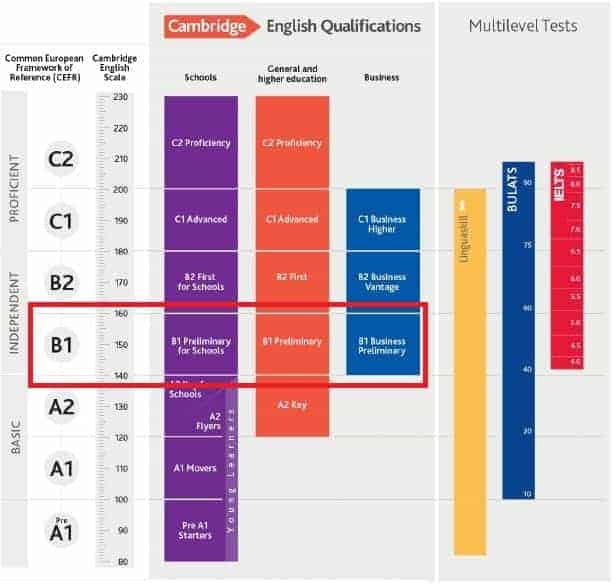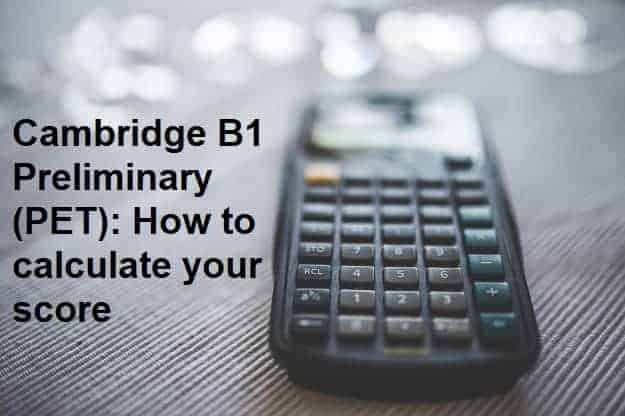Calculating your score in the PET exam can be a little bit confusing and a lot of students ask me how to do it. My short answer is always this:
There are two different ‘scores’ in the PET exam. The first one shows you the marks you get for each correct answer and the second one is your score on the Cambridge English Scale which we can calculate from your marks. Your score on the Cambridge English Scale is what you can see on your certificate and it shows you your level for each of the five exam parts. You reach B1 level with a score between 140-160.
In this article we are going to have a look at both scoring systems so you will understand how it works and you’ll be able to calculate your own score.
Why are there two different scores?
The Cambridge English Scale is a new system that we have used for a few years. At the beginning, it was a little bit confusing because in the old system you passed the exam with 60% or more and failed if you had less than that.
In the new system the 60% rule is still true, but we simply don’t use percent any more. Instead, you add up all your marks in the test to get your first score and then transfer this to the score on the Cambridge English Scale. This is then what you can find on your certificate.
How does the Cambridge English Scale work?
The Cambridge English Scale is a system to give the results of all the different exams (KET, PET, FCE, CAE, CPE) to the students who take these tests. You can compare the scores more easily and see the different levels of difficulty between the exams.

You can see all the different Cambridge English exams and also a few other exams on the right so you can compare the results in different tests. B1 is the level in the red box with score between 140-160.
In the PET exam it is even possible to get a higher score than 160 and if you do so, the certificate tells you that you finished the test with B2 level. In the old system that wasn’t possible.
The four different parts of PET
In the PET exam you get an overall score (140-160 on the Cambridge English Scale), but you also get a score for each of the four parts Reading, Writing, Listening and Speaking. The overall score is the average of the four different parts.
1. Reading
In the Reading paper there are six parts with a total of 32 questions. You can get 32 marks if you answer all the questions correctly. The Reading paper counts 25% towards your total score.
2. Writing
The Writing test contains of two parts and for each text you write you can score 20 marks or 40 marks in total. The Writing paper is worth 25% of your final score.
3. Listening
In the Listening exam you find four parts with a combined 25 questions. You can score one mark for each questions which means that you can get 25 marks in total and the Listening paper counts 25% towards your final result.
4. Speaking
The Speaking exam covers four different parts and in each part you have to do different things. Everything combined can get you 25 marks and the Speaking paper, just like the other three, is worth 25% of your overall result.
Is it possible to fail the PET exam?
The good news is that you can’t really fail the exam. You always get a certificate, but, of course, the score that you get might not be good enough for your circumstances.
However, your goal should be to get an overall score on the Cambridge English Scale of at least 140. Basically, this is equal to 60% in the old pass/fail system. If your score in any of the four parts Reading, Writing, Listening or Speaking falls below 120, there won’t be a score for this part on your certificate.
If you need more information,…
you can get more information in the video below. It describes the Cambridge English Scale very well. If you want more information on the PET exam, click here and read my article that tells you everything you need to know about Cambridge B1 Preliminary.
I hope you know now how the Cambridge English Scale and the scoring in the PET exam work. If you have questions, leave a comment and I will try to help you as fast as possible.
Lots of love,
Teacher Phill 🙂








what if you do less than 120 in one part of the exam (B1 preliminary for schools)? because i know that there’s a minimum score in each part of the exam, but i don’t know which is it.
11/3/2020 6:18:15 AM
Hello Teachers,
Perhaps you can help provide a little clarity to the methodology.
Emma sought to walk from 62.5% to some number on the Cambridge Scale. Is her answer approximately 144 on the Cambridge Scale out of 230?
Would that also coincide with the following numbers? Note: Min. and Max. are only references for this example.
Cambridge Scale Min. 140 = B1
Cambridge Scale Max. 230 = C2
140/230 = .6087 or 61%
Therefore, is it appropriate to advise an exam candidate that a percentage of 61 should place them at a B1 performing level?
Hi there,
Thank you for your comment.
I wouldn’t relate the score in one of the exams to the maximum one can reach on the scale itself. You need to take the number of marks a candidate scores in a specific exam (e.g. B1 Preliminary) and convert them to a scale score. Generally speaking, 60% of marks equal the level indicated by the exam (e.g. 60% of the marks in B1 Preliminary indicates B1-level English abilities, or 60% in C1 Advanced indicates C1-level abilities).
What the scale does is to let the different exams overlap a little bit so that you can reach a higher level than indicated in the exam with an outstanding result (e.g. you certificate in B1 Preliminary can say that a candidate has B2-level English abilities).
To sum up, Cambridge exams are separate for each level (unlike IELTS) so we have to look at the percentages with caution. You can also have a look at the link below to get some more information:
https://www.cambridgeenglish.org/exams-and-tests/cambridge-english-scale/
11/4/2020 6:11:20 AM second reply
11/3/2020 7:56:18 PM first reply
Hello,
Thank you for the same day response.
The purposeful intent to broaden the unit of measure by the scale itself was to look at how the candidate’s scores raked out of the entire scale. Likewise, we are challenged by your content that 60% is passing in B1, considering its dispute by factors referenced below.
We already averaged the candidate’s performance on the total B1 exams. At this point, we are using massaged numbers until the candidate completes a mock exam. Never the less, we did the following:
*Formula: (score/no. items) x 100
Reading = (23/32) x 100 = 71.875
Writing = (24/40) x 100 = 60
Listening = (18/25) x 100 = 72
Speaking = (18/30) x 100 = 60
Average% = (R+W+L+S)/4 = 65.969
At this point we used 230. Noting the error of our ways, what methodology gets us from the quantitative numbers to the scale? We cannot get there applying that percentage to the maximum range of B1.
We then returned to this link (https://kseacademy.com/cambridge/how-calculate-score-cambridge-exam/#how-to-calculate-the-score-for-b1-preliminary-pet) and put our rounded percentage in their calculator and received a scale factor of 137. We then used the old 70% usually on the B1 practice exams in English Aula and received the lowest passing scale for B1.
We understand the logic behind the percentage and the scale factors. What is not clear is the same utterance by many others: what is the computation to get from percentage to the scale factor that a candidate and their funding source could understand?
*Credit from this link: (https://kseacademy.com/cambridge/how-calculate-score-cambridge-exam/#how-to-calculate-the-score-for-b1-preliminary-pet)
Interestingly, we came across this very matter for each year between 2016 and 2018 when scoring candidate’s mock exams. A not to local Cambridge office was reluctant to share their table that enables us to determine pass or fail. When their numbers were challenged, they were quite defensive and stated that they came up with a formula that works for them. Hence, we no longer work with them and are this time trying people like yourself and the referenced link as guidance. The protraction without provided no relevance to the scale.
As I am not a mathematician and I’m also not the one who created the scale, I can only extrapolate the scale scores from the marks the student get in their tests.
The actual formula is Cambridge’s secret. 🙂
Hi Teacher Phil,
thank you for your article.
Is this information current with the new 2020 exam? I think it would help if there was a date on your article.
I find the Cambridge Scale system ellusive. I would like to know the equivalent on the Cambridge of 80 to 230 scale of any percentage score. So say if my student gets 20 marks correct out of the 32 in her reading exam I know she has 62.5% (if indeed every question has the same weight?). So what would that correspond to on the Cambridge scale? How can I calculate one from the other? I need to know the mathematic calculation to go from a percentage, which I can easily work out, to the Cambridge Scale, which mysteriously appears to start at 80 and finish at 230! Maybe it’s supposed to be ellusive lest someone copy it! Why can’t they stick with easy to understand percentages?
Your opinion would be most valuable. My students are mystified when I can’t tell them whether their 20 correct answers in the reading exam translates to a B1 pass or an A2 (failure of B1) or a B2. I need to be able to tell them instantly where they are!
I would be very happy if you can shed any light on this matter.
All the best,
Emma
Hi Emma,
Thank you for your comment.
The article is current with the 2020 exam even though this is irrelevant for the Cambridge Scale system. The only difference is that Reading and Writing are now two standalone papers, but they have always been marked separately.
As for the conversion from marks to Cambridge Scale score, I think Cambridge keeps this a secret, but you can still go with a rough “60% to pass” guideline, so for example 20/32 marks in the Reading paper would be 60% and equivalent to a score of 140 (B1) on the Cambridge Scale, 26 marks are roughly 80% or 160 on the scale (B2) and everything below 20 marks is A2.
With the scale Cambridge only changed the nomenclature, but you can still use percentages to tell your students if they do well or not.
I hope this helps at least a little bit.
All the best,
Teacher Phill